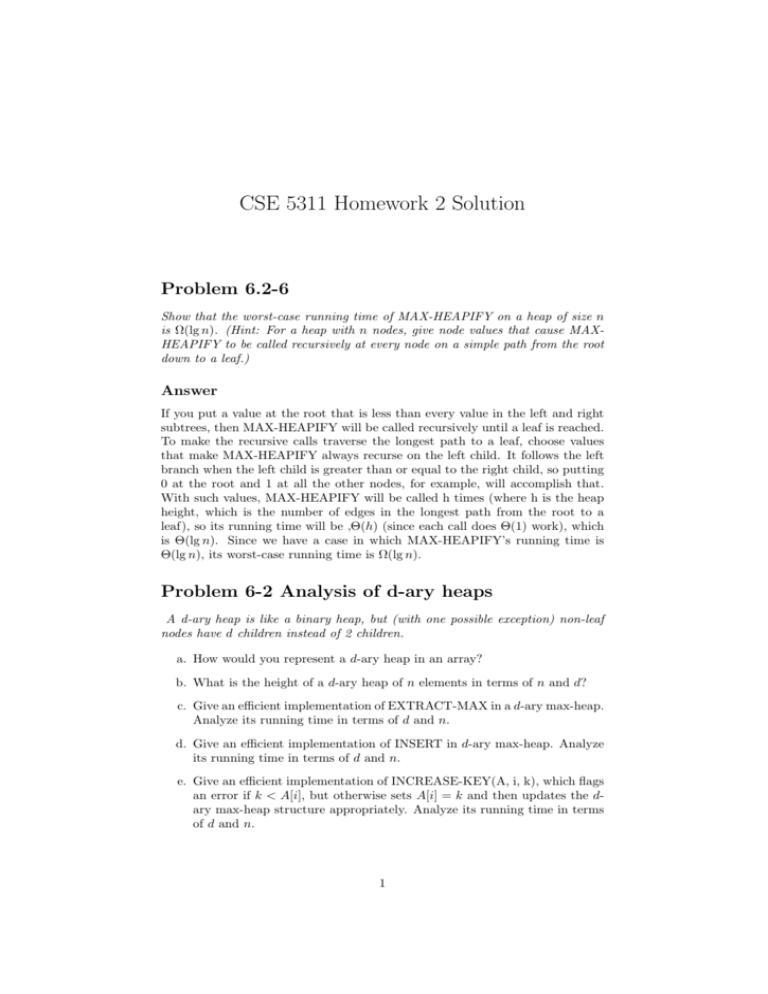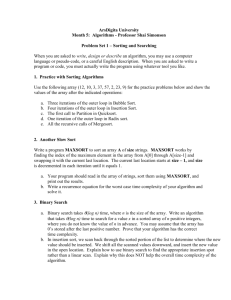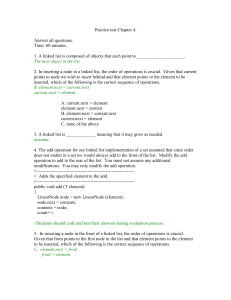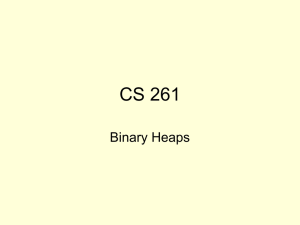CSE 5311 Homework 2 Solution
advertisement

CSE 5311 Homework 2 Solution
Problem 6.2-6
Show that the worst-case running time of MAX-HEAPIFY on a heap of size n
is Ω(lg n). (Hint: For a heap with n nodes, give node values that cause MAXHEAPIFY to be called recursively at every node on a simple path from the root
down to a leaf.)
Answer
If you put a value at the root that is less than every value in the left and right
subtrees, then MAX-HEAPIFY will be called recursively until a leaf is reached.
To make the recursive calls traverse the longest path to a leaf, choose values
that make MAX-HEAPIFY always recurse on the left child. It follows the left
branch when the left child is greater than or equal to the right child, so putting
0 at the root and 1 at all the other nodes, for example, will accomplish that.
With such values, MAX-HEAPIFY will be called h times (where h is the heap
height, which is the number of edges in the longest path from the root to a
leaf), so its running time will be Θ(h) (since each call does Θ(1) work), which
’
is Θ(lg n). Since we have a case in which MAX-HEAPIFY’s running time is
Θ(lg n), its worst-case running time is Ω(lg n).
Problem 6-2 Analysis of d-ary heaps
A d-ary heap is like a binary heap, but (with one possible exception) non-leaf
nodes have d children instead of 2 children.
a. How would you represent a d-ary heap in an array?
b. What is the height of a d-ary heap of n elements in terms of n and d?
c. Give an efficient implementation of EXTRACT-MAX in a d-ary max-heap.
Analyze its running time in terms of d and n.
d. Give an efficient implementation of INSERT in d-ary max-heap. Analyze
its running time in terms of d and n.
e. Give an efficient implementation of INCREASE-KEY(A, i, k), which flags
an error if k < A[i], but otherwise sets A[i] = k and then updates the dary max-heap structure appropriately. Analyze its running time in terms
of d and n.
1
Answer
a.
We can represent a d-ary heap in a 1-dimensional array as follows. The root
resides in A[1], its d children reside in order in A[2] through A[d + 1, their
children reside in order in A[d + 2] through A[d2 + d + 1], and so on. The
following two procedures map a node with index i to its parent and to its j-th
child (for 1 ≤ j ≤ d), respectively.
D−ARY−PARENT( i )
r e t u r n b(i − 2)/d + 1c
D−ARY−CHILD( i , j )
r e t u r n d(i + 1) + j + 1
To convince yourself that these procedures really work, verify that
D−ARY−PARENET(D−ARY−CHILD( i , j ) ) = i ,
for any 1 ≤ j ≤ d. Notice taht the binary heap procedures are a special case of
the above procedures when d = 2.
b.
Since each node has d children, the height of a d-ary heap with n nodes is
Θ(logd n) = Θ(lg d/ lg n).
c.
The procedure HEAP-EXTRACT-MAX given in the text for binary heaps works
fine for d-ary heaps too. The change needed to support d-ary heaps is in MAXHEAPIFY, which must compare the argument node to all d children instead of
just 2 children. The running time of HEAP-EXTRACT-MAX is still the running time for MAX-HEAPIFY, but that now takes worst-case time proportional
to the product of the height of the heap by the number of children examined at
each node (at most d), namely Θ(d logd n) = Θ(d lg d/ lg n).
d.
The procedure MAX-HEAP-INSERT given in the text for binary heaps works
fine for d-ary heaps too, assuming that HEAP-INCREASE-KEY works for d-ary
heaps. The worst-case running time is still Θ(h), where h is the height of the
heap. (Since only parent pointers are followed, the number of children a node
has is irrelevant.) For a d-ary heap, this is Θ(logd n) = Θ(lg d/ lg n).
e.
The HEAP-INCREASE-KEY procedure with two small changes works for dary heaps. First, because the problem specifies that the new key is given by the
parameter k, change instances of the variable key to k. Second, change calls of
PARENT to calls of D-ARY-PARENT from part (a).
In the worst case, the entire height of the tree must be traversed, so the
worstcase running time is Θ(h) = Θ(logd n) = Θ(lg d/ lg n).
2
Problem 7.2-2
What is the running time of QUICKSORT when all elements of the array A
have the same value?
Answer
It is Θ(n2 ), since one of the partitions is always empty (see exercise 7.1.2).
Problem 7-1 Hoare partition correctness
The version of PARTITION given in this chapter is not the original partitioning
algorithm. Here is the original partition algorithm, which is due to C.A.R.
Hoare:
HOARE−PARTITION(A, p , r )
x = A[ p ]
i = p − 1
j = r + 1
w h i l e TRUE
repeat
j = j − 1
u n t i l A[ j ] <= x
repeat
i = i + 1
u n t i l A[ i ] >= x
if i < j
exchange A[ i ] with A[ j ]
e l s e return j
a. Demonstrate the operation of HOARE-PARTITION on the array A =
h13, 19, 9, 5, 12, 8, 7, 4, 11, 2, 6, 21i, showing the values of the array and auxiliary values after each iteration of the while loop in lines 4-13.
The next three questions ask you to give a careful argument that the procedure HOARE-PARTITION is correct. Assuming that the subarray A[p..r]
contains at least two elements, prove the following:
b. The indices i and j are such that we never access an element of A outside
the subarray A[p..r].
c. When HOARE-PARTITION terminates, it returns a value j such that
p ≤ j < r.
d. Every element of A[p..j] is less than or equal to every element of A[j +1..r]
when HOARE-PARTITION terminates.
The PARTITION procedure in section 7.1 separates the pivot value (originally in A[r]) from the two partitions it forms. The HOARE-PARTITION
procedure, on the other hand, always places the pivot value (originally in A[p])
into one of the two parititions A[p..j] and A[j + 1..r]. Since p ≤ j < r, this split
is always nontrivial.
Rewrite the QUICKSORT procedure to use HOARE-PARTITION.
3
Answer
Demonstration
At the end of the loop, the variables have the following values:
x = 13
j = 9
i = 10
Correctness
The indices will not walk of the array. At the first check i < j, i = p and j ≥ p
(because A[p] = x). If i = j, the algorithm will terminate without accessing
”invalid” elements. If i < j, the next loop will also have indices i and j within
the array, (because i ≤ r and j ≥ p). Note that if one of the indices gets to the
end of the array, then i won’t be less or equal to j any more.
As for the return value, it will be at least one less than j. At the first
iteration, either (1) A[p] is the maximum element and then i = p and j = p < r
or (2) it is not and A[p] gets swapped with A[j] where j ≤ r. The loop will
not terminate and on the next iteration, j gets decremented (before eventually
getting returned). Combining those two cases we get p ≤ j < r.
Finally, it’s easy to observe the following invariant:
Before the condition comparing i to j, all elements A[p..i − 1] ≤ x
and all elements A[j + 1..r] ≥ x.
Initialization. The two repeat blocks establish just this condition.
Maintenance. By exchanging A[i] and A[j] we make the A[p..i] ≤ x and
A[j..r] ≥ x. Incrementing i and decrementing j maintain this invariant.
Termination. The loop terminates when i ≥ j. The invariant still holds at
termination.
The third bit follows directly from this invariant.
Implementation
There’s some C code below.
#i n c l u d e <s t d b o o l . h>
int hoare partition ( int A[ ] , int p , int r ) {
i n t x = A[ p ] ,
i = p − 1,
j = r,
tmp ;
while ( true ) {
do { j −−; } w h i l e ( ! ( A[ j ] <= x ) ) ;
do { i ++; } w h i l e ( ! ( A[ i ] >= x ) ) ;
if (i < j) {
tmp = A[ i ] ; A[ i ] = A[ j ] ; A[ j ] = tmp ;
} else {
return j ;
4
}
}
}
void qui cksor t ( i n t A[ ] , i n t p , i n t r ) {
i f (p < r − 1) {
i n t q = h o a r e p a r t i t i o n (A, p , r ) ;
q u i c k s o r t (A, p , q + 1 ) ;
q u i c k s o r t (A, q + 1 , r ) ;
}
}
Problem 8.1-3
Show that there is no comparison sort whose running time is linear for at least
half of the n! inputs of length n. What about a fraction 1/n of the inputs of
length n? What about a fraction 1/2n ?
Answer
If it is linear for at least half of the inputs, then using the same reasoning as in
the text, it must hold that:
n!
≤ 2n
2
This holds only for small values for n. Same goes for the other:
n!
≤ 2n
n
And:
n!
≤ 2n ⇔ n! ≤ 4n
2n
All those have solutions for small n < n0 , but don’t hold for larger values.
In contrast, insertion sort gets its work done in Θ(n) time in the best case.
But this is a 1/n! fraction of the inputs, which is smaller than 1/2n .
Problem 8-3 Sorting variable-length items
1. You are given an array of integers, where different integers may have
different number of digits, but the total number of digits over all the
integers in the array is n. Show how to sort the array in O(n) time.
2. You are given an array of strings, where different strings may have different
numbers of characters, but the total number of characters over all the
strings is n. Show how to sort the strings in O(n) time.
(Note that the desired order here is the standard alphabetical order; for
example; a < ab < b.)
5
Answer
The numbers
For the numbers, we can do this:
1. Group the numbers by number of digits and order the groups Radix sort
each group
2. Let’s analyze the number of steps. Let Gi be the group of numbers with
i digits and ci = |Gi |. Thus:
T (n) =
X
nci · i = n
i=1
The strings
For the strings, we can do this:
1. Groups the strings by length and order the groups
2. Starting i on the maximum length and going down to 1, perform counting
sort on the ith character. Make sure to include only groups that have an
ith character.
If the groups are subsequent subarrays in the original array, we’re performing
counting sort on a subarray ending on the last index of the original array.
Problem 9-1 Largest i numbers in sorted order
Show that the second smallest of n elements can be found with n + dlg ne − 2
comparisons in the worst case. (Hint: Also find the smallest element.)
Answer
We can compare the elements in a tournament fashion - we split them into
pairs, compare each pair and then proceed to compare the winners in the same
fashion. We need to keep track of each ”match” the potential winners have
participated in.
We select a winner in n − 1 matches. At this point, we know that the second
smallest element is one of the lg n elements that lost to the smallest each of
them is smaller than the ones it has been compared to, prior to losing. In
another dlg ne − 1 comparisons we can find the smallest element out of those.
This is the answer we are looking for.
Problem 12.3-3
We can sort a given set of n numbers by first building a binary search tree
contain- ing these numbers (using TREE-INSERT repeatedly to insert the numbers one by one) and then printing the numbers by an inorder tree walk. What
are the worst- case and best-case running times for this sorting algorithm?
6
Answer
Here’s the algorithm:
TREE−SORT(A)
l e t T be an empty b i n a r y s e a r c h t r e e
f o r i = 1 to n
TREE−INSERT(T, A[ i ] ) ;
INORDER−TREE−WALK(T . r o o t )
Worst case: Θ(n2 )—occurs when a linear chain of nodes results from the
repeated TREE-INSERT operations.
Best case: Θ(n lg n)—occurs when a binary tree of height Θ(lg n) results
from the repeated TREE-INSERT operations.
Problem 13.1-4
Suppose that we “absorb” every red node in a red-black tree into its black parent,
so that the children of the red node become children of the black parent. (Ignore
what happens to the keys.) What are the possible degrees of a black node after all
its red children are absorbed? What can you say about the depths of the leaves
of the resulting tree?
Answer
After absorbing each red node into its black parent, the degree of each node
black node is
• 2, if both children were already black,
• 3, if one child was black and one was red, or
• 4, if both children were red.
All leaves of the resulting tree have the same depth.
Problem 13.1-5
Show that the longest simple path from a node x in a red-black tree to a descendant leaf has length at most twice that of the shortest simple path from node x
to a descendant leaf.
Answer
In the longest path, at least every other node is black. In the shortest path, at
most every node is black. Since the two paths contain equal numbers of black
nodes, the length of the longest path is at most twice the length of the shortest
path.
We can say this more precisely, as follows:
Since every path contains bh(x) black nodes, even the shortest path from x
to a descendant leaf has length at least bh(x). By definition, the longest path
7
from x to a descendant leaf has length height(x). Since the longest path has
bh(x) black nodes and at least half the nodes on the longest path are black (by
property 4), bh(x) ≤ height(x)/2, so
length of longest path = height(x) ≤ 2 · bh(x) ≤ twice length of shortest path.
8




